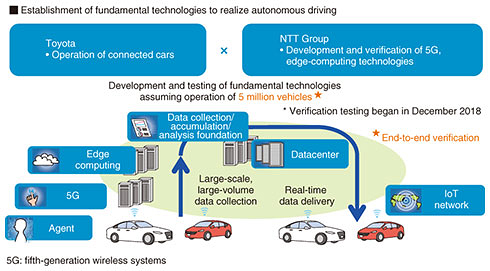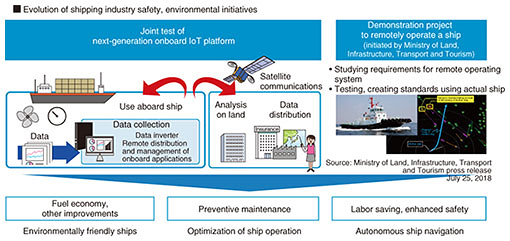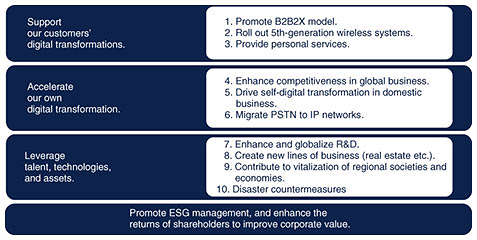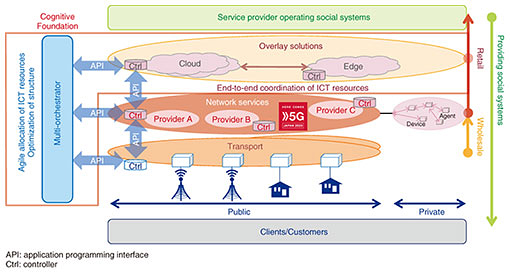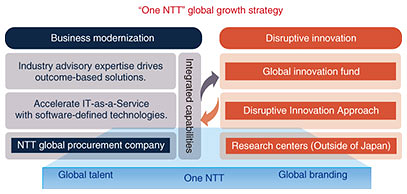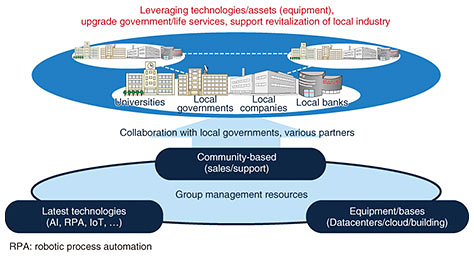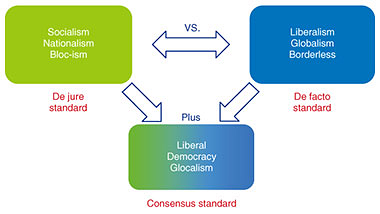 |
|||||||
|
|
|||||||
|
Feature Articles: Keynote Speeches at NTT R&D Forum 2018 Autumn Vol. 17, No. 2, pp. 6–14, Feb. 2019. https://doi.org/10.53829/ntr201902fa1 
Bringing the Smart World to LifeOverviewThis article introduces an NTT Group effort in new value creation to bring the smart world to life. The contents of this article are based on a lecture presented by Jun Sawada, NTT President and Chief Executive Officer, at NTT R&D Forum 2018 Autumn held November 29–30, 2018. Keywords: smart world, B2B2X, cognitive foundation, Your Value Partner 2025 1. Smart cityAn NTT Group objective is to help create a prosperous and happy future for everyone. With the aim of achieving smart cities, we have been working for some years on creating new value by utilizing data together with the cities of Sapporo, Fukuoka, and Yokohama through collaborations with industry, government, and academia. In this article, I will introduce NTT Group initiatives for the City of Las Vegas, where smart city initiatives are taking root and evolving, and new initiatives toward urban development and problem solving in Japan. 1.1 City of Las VegasThe NTT Group has been conducting joint trials on smart city solutions in the City of Las Vegas in partnership with Dell Technologies since September 2018 [1]. Our aim here is to construct a system that can detect the occurrence of incidents and help prevent crime by networking many cameras and sensors installed in downtown Las Vegas and analyzing pedestrian and traffic patterns. This system is based on a model that combines elements that perform recognition and detection at the network edge and elements that analyze and predict trends by artificial intelligence (AI). It features a variety of advanced technologies from the NTT laboratories including sensing technologies. A new software platform called Cognitive Foundation® has been prepared to interconnect these hardware and software elements (Fig. 1). The plan going forward is to expand the lineup of system functions to include solutions, traffic monitoring, and other functions that can provide an even higher level of public safety. We are also working on smart city initiatives in the State of Nevada [2]. Going forward, we plan to roll out smart city solutions throughout the United States in collaboration with Dell Technologies and NTT Group sales teams in the United States.
The NTT Group has been promoting the business-to-business-to-X (B2B2X) model as shown in Fig. 2. In this model, the NTT Group and its partners, which correspond to the first ‘B’ in B2B2X, seek to create new value by supporting main players, the second ‘B’ in B2B2X.
The City of Las Vegas corresponds to the second ‘B,’ and NTT and Dell Technologies, the first ‘B,’ do not own the collected data. The City of Las Vegas owns and utilizes such data, and our role is to support the creation of new value. Michael Sherwood, Director of Information Technologies for the City of Las Vegas, explained that the reason for selecting NTT and Dell Technologies was not only our specialized know-how in new data-use fields such as cybersecurity and data management, which Las Vegas needs for development, but also our proposal that the City of Las Vegas be a main player (an owner of the collected data). Data will be a basic resource for business and services, indeed for everyday life in society. In Japan, I think it should be local governments that own and control such data. I would like to roll out our smart city initiatives with this approach to data ownership on a global scale. 1.2 Urban solutions companyNTT completed its tender offer bid for NTT Urban Development Corporation, enabling NTT to acquire 95.2% of the company’s shares. Our aim here is to assist in urban development by combining the urban development expertise of NTT Urban Development and the construction- and power-related solutions of NTT Facilities with NTT Group assets and other technologies. We hope to achieve diversity, innovation, resilience, and communities by using information technology (IT) and communications as essential tools. I believe that by assisting in urban solutions in this way and broadening our scope as a business entity, we can contribute to society and the world at large. 2. Smart worldI introduce some examples concerning the smart world here. 2.1 Smart entertainmentIn the field of smart entertainment, we are aiming at providing a new sports viewing style in collaboration with J.League, Japan’s professional soccer league. We are also pursuing the integration of traditional Japanese performing arts with information and communication technology (ICT) in collaboration with SHOCHIKU Co., Ltd., a company engaged in motion pictures and theater operations, including kabuki (Fig. 3).
Kyoto’s Minamiza Theatre, famous for its kabuki plays, reopened on November 1, 2018, with equipment supporting NTT’s Kirari! immersive telepresence technology. The plan is to co-produce performances at this theater starting in the summer of 2019. Although the Minamiza Theatre has a long and rich tradition, our attempt is to fuse new traditions and new arts. 2.2 Smart manufacturingWe are undertaking a variety of projects in the field of smart manufacturing. For example, we are working on smart plants with JSR Corporation, remote control of construction and mining machinery with Komatsu Ltd., data usage at manufacturing sites with FANUC CORPORATION, and detection and response support for unknown cyber-attacks on industrial control systems with Mitsubishi Heavy Industries, Ltd. Our project with JSR on smart plants involves a collaboration with Accenture Japan Ltd. on digitizing explicit knowledge using AI, voice recognition, and sensors (Fig. 4). Going forward, we aim to connect all sorts of things through Internet of Things (IoT) technology as a connected value chain and to create a structure that enhances added value not in a partial manner but throughout the industrial complex. Doing so, however, is an extremely difficult task since batteries cannot be used. A short circuit in a battery can result in an explosion, which is why there are regulations prohibiting the use of batteries in petrochemical complexes. For this reason, we are using explosion-proof sensors developed by NTT Advanced Technology and inQs Co., Ltd. that incorporate dye sensitization technology for generating electric power using infrared light.
2.3 Smart mobilityIn the field of smart mobility, we are working with Toyota Motor Corporation on fundamental technologies for achieving autonomous driving, with NYK Line and MTI Co., Ltd. on ship safety and environmental initiatives, and with East Japan Railway Company on seamless transportation. (1) Toyota Full-scale verification testing with Toyota toward autonomous driving began in December 2018. Up to now, trials involving the running of one or two cars have taken place at various locations, but in the future, a platform that can process data on a scale of several tens of millions of vehicles will be essential. With this in mind, our initial experiments will assume the operation of five million vehicles. These experiments will test a connected car platform that can process the data collected from cars at a datacenter and transfer the data processing results to other vehicles in the field to achieve an end-to-end data flow (Fig. 5). The plan is to continue with these tests during specific time periods and assuming a variety of cases. I would like to turn this platform that we are creating together with Toyota into a model that can be used by other companies throughout the world, including other automobile companies.
(2) NYK Line and MTI We are working with NYK Line and MTI on a smart ship initiative involving an onboard IoT platform that can improve fuel economy, achieve preventive maintenance, and enhance safety by collecting onboard data and managing that data even from land using satellite communications (Fig. 6). I would like to apply this platform to container ships and other types of vessels with the aim of achieving a ship-to-ship connected world.
3. NTT Group Medium-Term Management Strategy: Your Value Partner 2025In autumn 2018, I announced The NTT Group Medium-Term Management Strategy called Your Value Partner 2025. Around that time, the Japanese government was promoting the separation of handset and network charges in the mobile communications market. To remain a market leader, I therefore asked NTT DOCOMO to announce a cut in mobile phone fees and incorporated the reduction in revenue in our Medium-Term Management Strategy. In retrospect, the separation of terminals also took place in 1985 when competition was introduced in the fixed telephone (landline) market, or public switched telephone network (PSTN). This separation of telephone sets and networks in the PSTN resulted in a significant expansion of the telephone-set market. Similarly, the separation of mobile handsets should stimulate competition in the mobile communications and handset markets, which I think is healthy all in all. On the other hand, this presents a challenging situation for NTT DOCOMO, but by entering into such a situation on our own initiative, we can face this issue with the intention of becoming a company that can provide our customers with even better services while remaining the market leader. 3.1 Future trendsThe Medium-Term Management Strategy envisions 3-year, 5-year, and 7-year milestones. Here, the fifth-generation wireless system (5G) is scheduled to commence within three years, and the PSTN is scheduled to complete its migration to Internet protocol (IP) telephony in seven years. At the same time, it appears that globalism and bloc-ism in society will continue to coexist for some years. Amid these trends, Osaka City was selected to host the World Expo in 2025. The NTT Group as well is promoting a variety of initiatives with the aim of supporting the Tokyo Olympic and Paralympic Games a year and a half from now and the Osaka Expo in seven years. There are also key trends taking place in the world of IT. Given the imminent end of Moore’s law, the need has arisen for new architecture and systems, and meanwhile, it is predicted that robots will replace half of the workforce in seven years. To put it another way, this means that each and every person will be able to engage in more enriching work and cultural activities. I think that we can expand our market by supporting people in these endeavors. 3.2 Further phase changesIn regard to phase changes as a communications and IT operator, NTT’s business model is making a transition from business-to-consumer (B2C) to B2B2X, as I mentioned earlier. We can also expect all-out competition as mobile handsets and the network come to be separated, as well as shifts from communications services to digital services, from the cloud to virtualization and AI-based infrastructures, and from mobile/FTTH (fiber to the home) to 5G and smart devices in access networks. 3.3 Outline of Medium-Term Management StrategyNTT seeks to become Your Value Partner that customers continue to select. To this end, the Medium-Term Management Strategy calls for both growth investment and cost reductions to increase profits, and introduces return on invested capital (ROIC) as a key performance indicator. The strategy declares the NTT Group mission to be resolving social issues and the NTT Group vision to be embodied by the Your Value Partner concept. By pursuing this mission and vision, we would like to contribute to achieving a sustainable society by meeting SDGs (Sustainable Development Goals) initiated by the United Nations and to the realization of Society 5.0 proposed by the Japanese government [3]. I believe that our mission is to solve social problems through collaboration with our business partners while maintaining a healthy balance between the roles of a public utility and private company that the NTT Group has had from the beginning. While we are aiming to be Your Value Partner, the main figure of the NTT Group vision is people. In the end, it is people that drive innovation, technology development, and research and development (R&D), and the values shared among people are connections, trust, and integrity. The idea of connections in this case does not refer to network connections but rather to the connection of things by IoT and the connection of systems going forward. It also includes the concept of helping people to connect with each other and connecting the present with the future. The NTT Group Medium-Term Management Strategy consists of four elements (Fig. 7). To begin with, we will support our customers’ digital transformation by accelerating our own digital transformation. At the same time, we will pursue growth by leveraging talent, technologies, and assets. Finally, at the base of these elements, we will promote ESG (environmental, social, and governance) management and shareholder return. We have established ten measures to achieve these goals. Here, I would like to highlight the measures related to R&D.
(1) Roll out 5G services The 5G system is slated to be the next network. Given that it is a public network, end-to-end services will be achieved by adding private networks and functions and systems within factories, on vehicles, and in other areas. The three-layer model shown in Fig. 8 features overlay solutions at the top, but to provide such solutions as social systems, various types of things will have to be coordinated within the network-services layer. Additionally, 5G aside, an optical fiber network will run as far as base stations, which means a transport layer at the bottom of this model that will also require coordination. In other words, it is necessary to deploy functions that can orchestrate and manage all three layers, and these functions will be achieved through software-defined technologies. One example of an overlay solution here is the Cognitive Foundation platform we are working on in the City of Las Vegas.
(2) Enhance competitiveness in global business We are planning to reorganize the NTT Communications Group and Dimension Data Group into two companies, one focused on the global market and the other on the Japanese market, by July 2019. As a corporation reorganized under the One NTT brand, I would like to support the modernization of our customers’ businesses (Fig. 9). To this end, we will provide a variety of integrated solutions from datacenter services to applications, and we will do this through outcome-based solutions driven by industry expertise, IT-as-a-Service using software-defined technologies, and efficiency gains via an NTT global procurement company.
However, our customers’ digital transformations cannot be achieved by this alone. There will be no appealing solutions without including disruptive innovation. For this reason, we have established global R&D centers for long-term development projects and created a global innovation fund. The purpose of this fund is not to launch new businesses but rather to connect people who wish to pursue new business ventures and support them through medium-term incubation. The fund was launched in the United States with an American as head. Additionally, the Disruptive Innovation Approach team will enhance our advisory functions. This team will propose a digital or smart world to our customers in the short term. In this way, we plan to incorporate long-term, medium-term, and short-term initiatives within our solutions. (3) Enhance and globalize R&D We will strengthen our joint R&D. I think that communications and IT should be and will be natural things—if not, they would not be usable. We would like to conduct more research on natural awareness, techniques, and methods of use. In addition, I would like to expand basic research beyond present levels at overseas bases in such areas as super-secure certification technology, quantum computation theory, and biomedical technology. To this end, we will increase our R&D investment in high-growth areas by about 10% to 2 trillion yen over the next five years. Apart from this, we will invest 1 trillion yen over the next five years in 5G infrastructure build-out. (4) Contribute to revitalization of regional societies/economies The Cabinet Office of Japan is advocating a Super City initiative, while the Ministry of Land, Infrastructure, Transport and Tourism is promoting the concept of Compact Cities. For Japan, city development is a major issue going forward. In this regard, I think that we can support various regions in Japan using the latest technologies, facilities, and sites of the NTT Group (Fig. 10). Recent years have seen a confrontation between movements in socialism (nationalism, bloc-ism) and in liberalism (globalism, borderless world). While nationalism and bloc-ism are determined by a de jure standard, globalism and the borderless world are determined by a de facto standard. From here on, however, if we devise the solution of problems together with local communities, the concept of glocalism, which combines the meanings of global and local, will no doubt become pronounced in society. This will result in a structure 70–80% of which is dominated by local, and in this case, I believe that glocalism will be determined by a consensus standard (Fig. 11).
(5) Disaster countermeasures Finally, I would like to talk about disaster countermeasures. In Japan, 2018 was a year of many disasters. Up to now, we have been striving to improve the reliability of the communications network, to secure critical communications, and to achieve prompt restoration. From here on, we must further reinforce the communications infrastructure. This will require proactive disaster responses using AI and other measures. Furthermore, taking into account the growing number of international visitors to Japan, we must work on disseminating helpful information in foreign languages as well. 3.4 Medium-term targetsThe Medium-Term Management Strategy sets medium-term financial targets that we seek to meet by executing the measures I have just described. These include a 50% increase in earnings per share (EPS) and cost reductions of at least 800 billion yen in five years. I would like to achieve this EPS growth by increasing profit. Thus, I want to increase overseas (outside Japan) sales from US$18 billion to $25 billion and raise overseas operating income margin from 3% to 7%. Here, we set ROIC to 8% to aim for an efficient return on investment. NTT’s total revenue stands at $106 billion, so its global revenues are still about 19% of the total. NTT is ranked 55th on the Fortune Global 500. It provides network services in over 190 countries and regions and ranks second in the world in datacenter space. NTT employs about 300,000 employees worldwide. 4. Accelerate our own digital transformation to become Your Value PartnerIn 1985, NTT’s revenues from PSTN business accounted for 83% of total revenues, but today, with voice revenues from cell phones included, it accounts for only 18%. In other words, all other sources of revenue have expanded substantially. This is a change that took about 30 years to occur. From here on, I would like to accelerate our own digital transformation to become Your Value Partner, meaning that our customers continue to choose us over others. As a consequence of this endeavor, our business portfolio will undergo great changes. I ask for everyone’s support in determining what the new NTT should become, and I look forward to promoting business development while holding discussions with our customers and other stakeholders. References
Trademark notesAll brand names, product names, and company/organization names that appear in this article are trademarks or registered trademarks of their respective owners. |
|||||||













